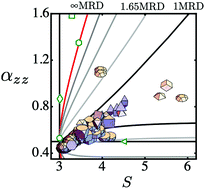Data driven analytics of porous battery microstructures†
Abstract
The microstructural optimization of porous lithium ion battery electrodes has traditionally been driven by experimental trial and error efforts, based on anecdotal understanding and intuition, leading to the development of useful but qualitative rules of thumb to guide the design of porous energy storage technology. In this paper, an advanced data-driven framework is presented wherein the effect of experimentally accessible microstructural parameters such as active particle morphology and spacial arrangement, underlying porosity, cell thickness, etc., on the corresponding macroscopic power and energy density is systematically assessed. For the LixC6 | LMO chemistry, an analysis performed on 53 356 battery architectures reported in the literature revealed that for commercial microstructures based on oblate-shaped particles, lightly textured samples deliver higher power and energy density responses as compared to highly textured samples, which suffer from large polarization losses. In contrast, high aspect ratio prolate-shaped particles deliver the highest energy and power density, particularly in the limit of wire-like morphologies. Polyhedra-based colloidal microstructures demonstrate high area densities, and low tortuosities, but provide no appreciable power and energy density benefit over currently manufactured particle morphologies. The developed framework enables to establish general microstructure design guidelines and propose optimal electrode microstructures based on the intended application, given an anode and cathode chemistry.



 Please wait while we load your content...
Please wait while we load your content...